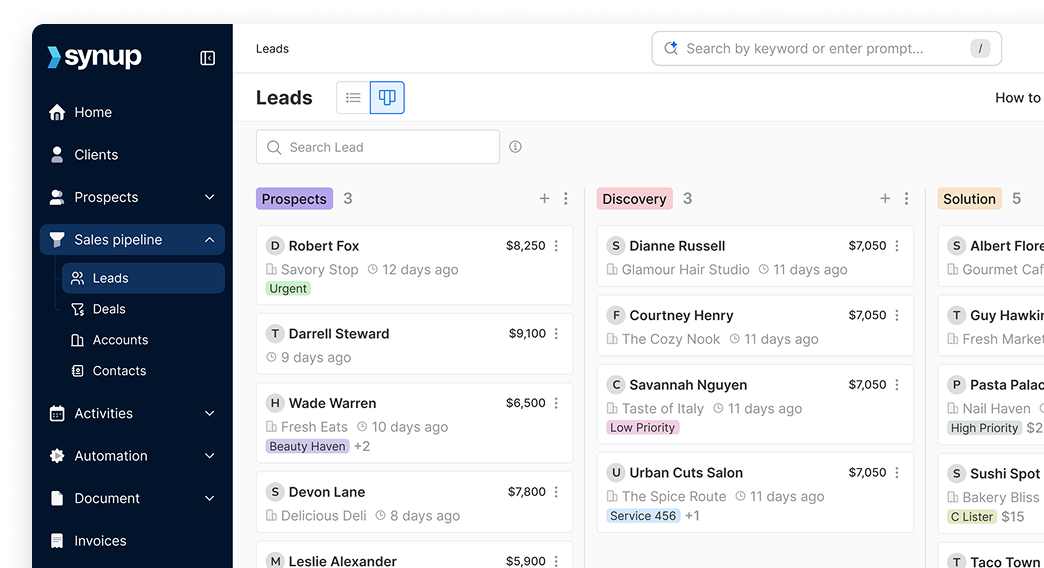Wie funktioniert das Google-Unternehmensprofil für Unternehmen im Servicebereich: Ein ausführlicher Leitfaden
Besitzen Sie ein Geschäft mit Servicebereich oder versuchen Sie, eines zu leiten? Hier finden Sie eine ausführliche Anleitung mit allen Vor- und Nachteilen, wie Sie Ihr GBP als SAB verwalten können.
Wenn Sie ein Service Area Business (SAB) betreiben und von lokalen Kunden wahrgenommen werden möchten, ist Google Business Profile (GBP) eines Ihrer besten Tools. Mit GBP können Sie Menschen in Ihrem Zielgebiet erreichen, auch wenn Sie kein Ladengeschäft haben. Egal, ob Sie Klempner, Landschaftsgärtner oder Caterer sind, ein starkes Google-Unternehmensprofil kann es potenziellen Kunden erheblich erleichtern, Sie zu finden und Ihnen zu vertrauen.
In diesem Leitfaden erklären wir, warum GBP für SABs unverzichtbar ist, wie Sie es richtig einrichten und wie Sie es optimieren können, damit Sie in den lokalen Suchergebnissen auffallen. Egal, ob Sie neu bei GBP sind oder Ihr Spiel verbessern möchten, in diesem Leitfaden finden Sie alles, was Sie wissen müssen.
Also fangen wir zuerst an mit...
Was ist ein Service Area Business?
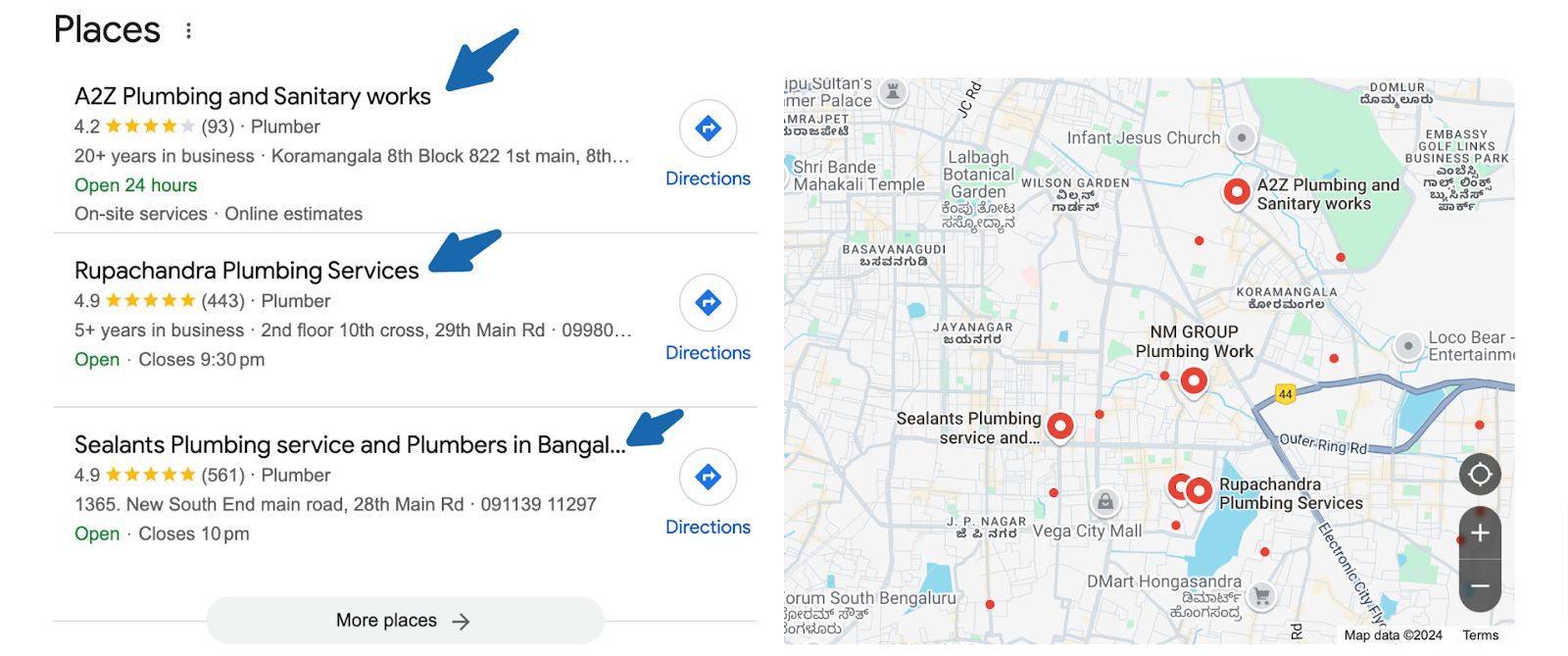
Ein Service Area Business (SAB) ist eine Art von Geschäft, das zu Ihnen kommt, anstatt von einem bestimmten Geschäft oder Büro aus zu operieren, das Sie besuchen. Stellen Sie sich das so vor: Anstatt ein Ladengeschäft zu haben, bieten SABs Dienstleistungen an, indem sie direkt zum Standort des Kunden fahren. Diese Unternehmen decken in der Regel ein breites Gebiet ab und sind oft in mehreren Stadtteilen, Städten oder sogar ganzen Städten tätig.
Hier ist eine Liste gängiger Beispiele für SABs:
- Klempner und Elektriker: Diese Fachleute kommen zu Ihnen nach Hause, um Probleme zu beheben, anstatt dass Sie sie besuchen.
- Dienstleistungen im Bereich Landschafts- und Rasenpflege: Rasenpflegeteams arbeiten vor Ort auf Ihrem Grundstück.
- Reinigungsdienste für Ihr Zuhause: Haushälterinnen und Reinigungskräfte kommen zu vereinbarten Terminen zu Ihnen nach Hause.
- Dienstleistungen zur Schädlingsbekämpfung: Diese Unternehmen besuchen Häuser und Büros, um Schädlingsprobleme zu lösen.
- Reparatur und Wartung von Klimaanlagen: Heizungs- und Kühltechniker kommen zu Ihnen, um Geräte zu warten oder zu installieren.
- Detaillierung des mobilen Autos: Anstelle einer Garage reinigen und detaillieren diese Dienste Ihr Fahrzeug an Ihrem Standort.
Diese Arten von Unternehmen sind oft leicht online zu finden und bieten Ihnen die Möglichkeit, einen Termin zu vereinbaren, der Ihrem Standort und Ihren Bedürfnissen am besten entspricht.
Die Bedeutung von GBP für Unternehmen im Servicebereich (SABs)
Die Rolle von GBP bei der lokalen Suche
Mit Google Business Profile präsentiert Google Kunden, die nach Dienstleistungen in der Nähe suchen, lokale Unternehmen. Für SABs, die nicht über ein Ladengeschäft verfügen, ist GBP wichtig, da Sie damit in den lokalen Suchergebnissen angezeigt werden, insbesondere im „Local Pack“ (den ersten drei Stellen, die bei einer Google-Suche ganz oben stehen). Mit GBP sind Sie auf der Karte, auch wenn Sie keine für die Öffentlichkeit sichtbare physische Adresse haben.
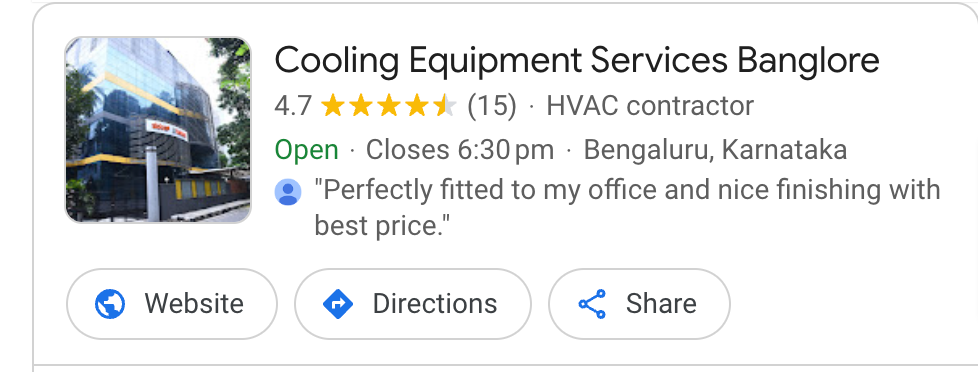
Sichtbarkeit versus Barrierefreiheit
Eine Herausforderung, der sich SAB gegenübersieht, ist der Aufbau einer Online-Präsenz, die sich greifbar anfühlt. Im Gegensatz zu herkömmlichen Schaufenstern haben Sie keinen physischen Ort, an dem Kunden vorbeikommen können. Daher ist es viel wichtiger, online gesehen zu werden. GBP macht Sie über Suchergebnisse und Karten für potenzielle Kunden zugänglich und hilft Ihnen, diese Sichtbarkeitslücke zu schließen.
Vertrauen und Glaubwürdigkeit aufbauen
Ein gutes GBP-Profil hilft Ihnen dabei, Glaubwürdigkeit aufzubauen. Bewertungen, Fotos und Servicebeschreibungen zeigen Kunden, dass Ihr Unternehmen legitim und leistungsfähig ist. Wenn jemand nach einem zuverlässigen Unternehmen in seiner Nähe sucht, hilft ihm ein gut gepflegtes Profil mit positiven Bewertungen, sich sicher zu fühlen, sich an Sie zu wenden.
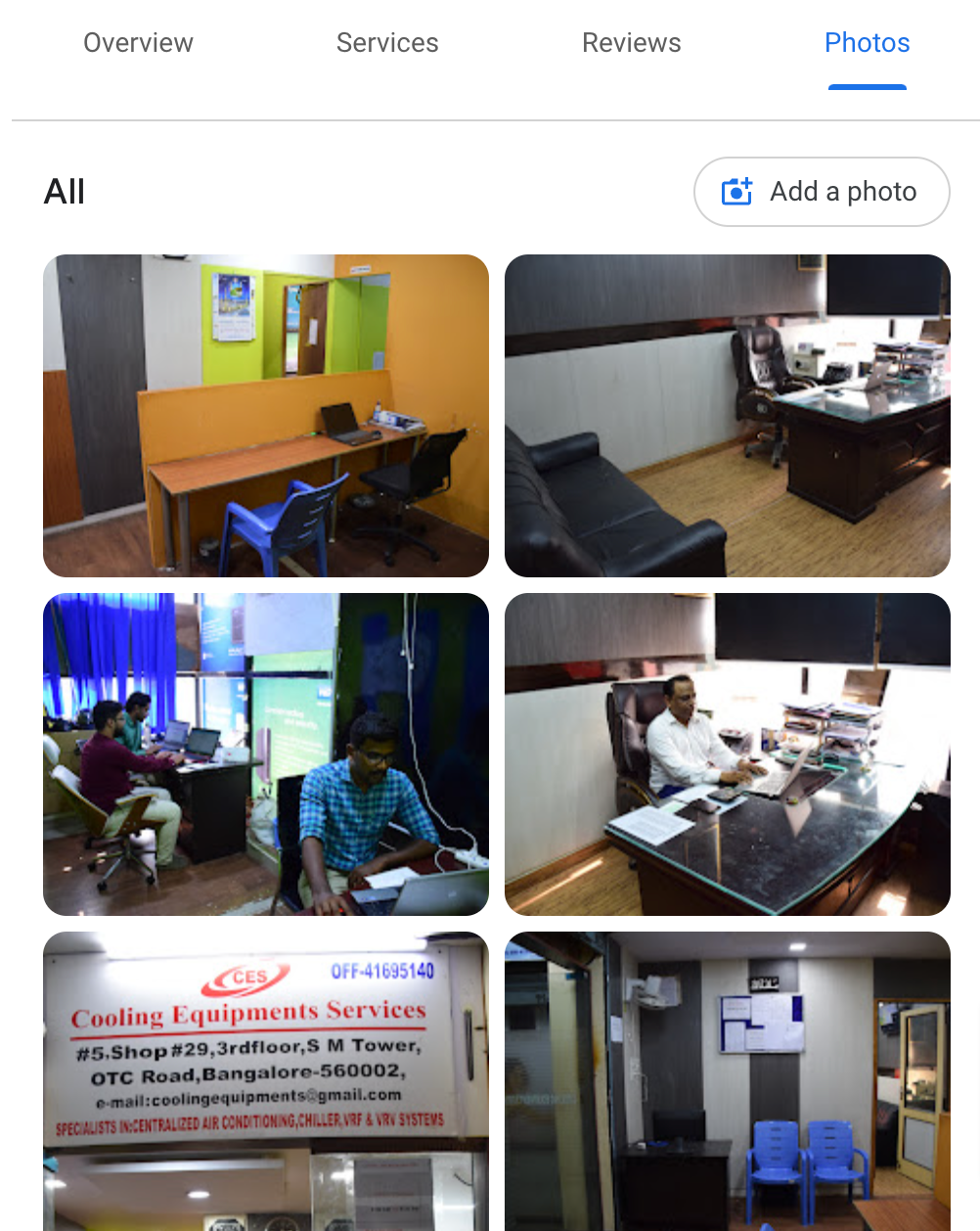
Einrichtung Ihres GBP für ein Unternehmen im Servicebereich
Die Einrichtung von GBP als SAB ist einfach, wenn Sie die Schritte kennen. Hier ist was zu tun ist:
Schritt 1:
Erstelle dein Google-Konto: Wenn Sie noch kein Google-Konto haben, erstellen Sie eines. Hier verwaltest du dein GBP. www.google.com/business/ ist der Ort, an dem Sie es einfach erstellen können.
Schritt 2:
Geschäftsinformationen hinzufügen: Geben Sie Ihre grundlegenden Informationen ein, einschließlich Firmenname, Telefonnummer und Geschäftskategorie. Stellen Sie sicher, dass Ihr Unternehmensname in allen Online-Einträgen einheitlich ist, um Ihre Glaubwürdigkeit zu erhöhen und Ihr lokales Suchranking zu verbessern.

Schritt 3:
Definieren Sie Ihren Servicebereich: Da Sie kein Ladengeschäft haben, ist dieser Schritt von entscheidender Bedeutung. Anstatt eine Adresse einzugeben, wählen Sie ein Servicegebiet aus, indem Sie Städtenamen, Postleitzahlen oder einen Radius um Ihren Standort hinzufügen. Dadurch erfahren Google und Ihre Kunden, wohin Sie bereit sind, zur Arbeit zu reisen.

Schritt 4:
Wählen Sie Betriebszeiten und Dienstleistungen: Wählen Sie Ihre Geschäftszeiten (auch wenn Sie keinen physischen Standort haben). Listen Sie Ihre wichtigsten Dienstleistungen auf, damit die Kunden genau wissen, was Sie anbieten. Stellen Sie sicher, dass diese Informationen korrekt sind, da dies eines der ersten Dinge ist, die sich die Leute ansehen werden.
Schritt 5:
Physische Adresse ausblenden: Wenn Sie von zu Hause aus arbeiten oder nicht möchten, dass Ihre Adresse veröffentlicht wird, können Sie sie ausblenden. Gemäß den Richtlinien von Google können SABs sich selbst auflisten, ohne eine Adresse anzuzeigen. Das hilft dir dabei, deine Privatsphäre zu wahren.

Schritt 6:
Servicekategorien hinzufügen: Wählen Sie eine Hauptkategorie, die Ihren Hauptdienst beschreibt. Du kannst auch sekundäre Kategorien hinzufügen, aber vermeide zu viele, da dies dein Profil verwässern könnte.
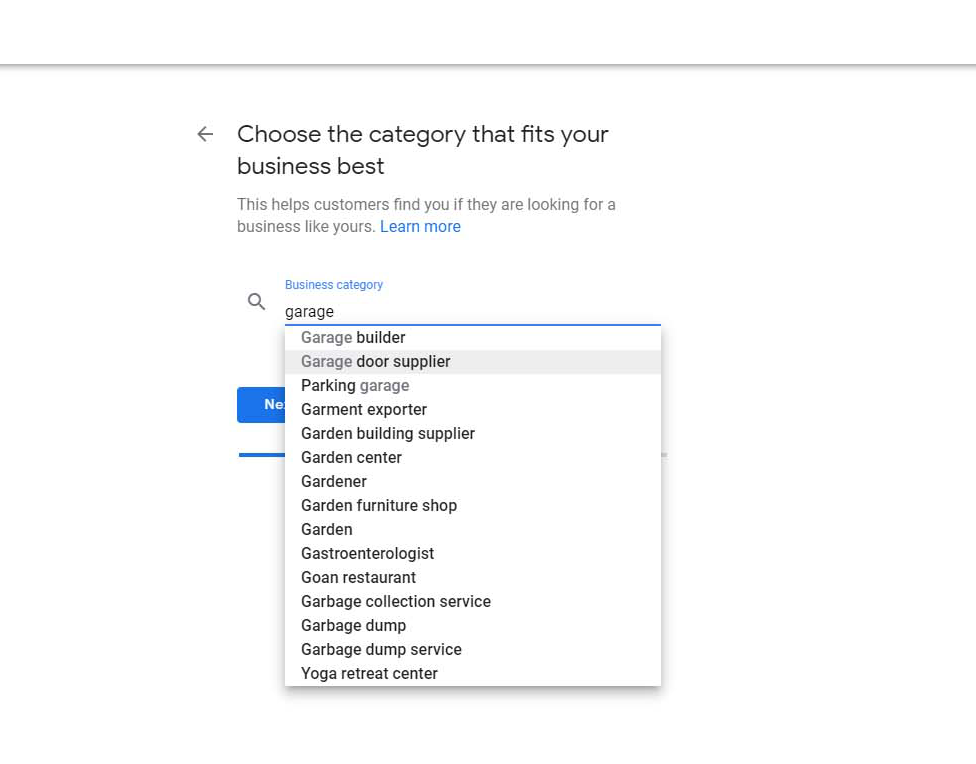
Das war's!
Sie sind bereit, mit dem weiteren Aufbau Ihres Profils zu beginnen.
Wie unterscheidet sich die lokale Suche für SABs?
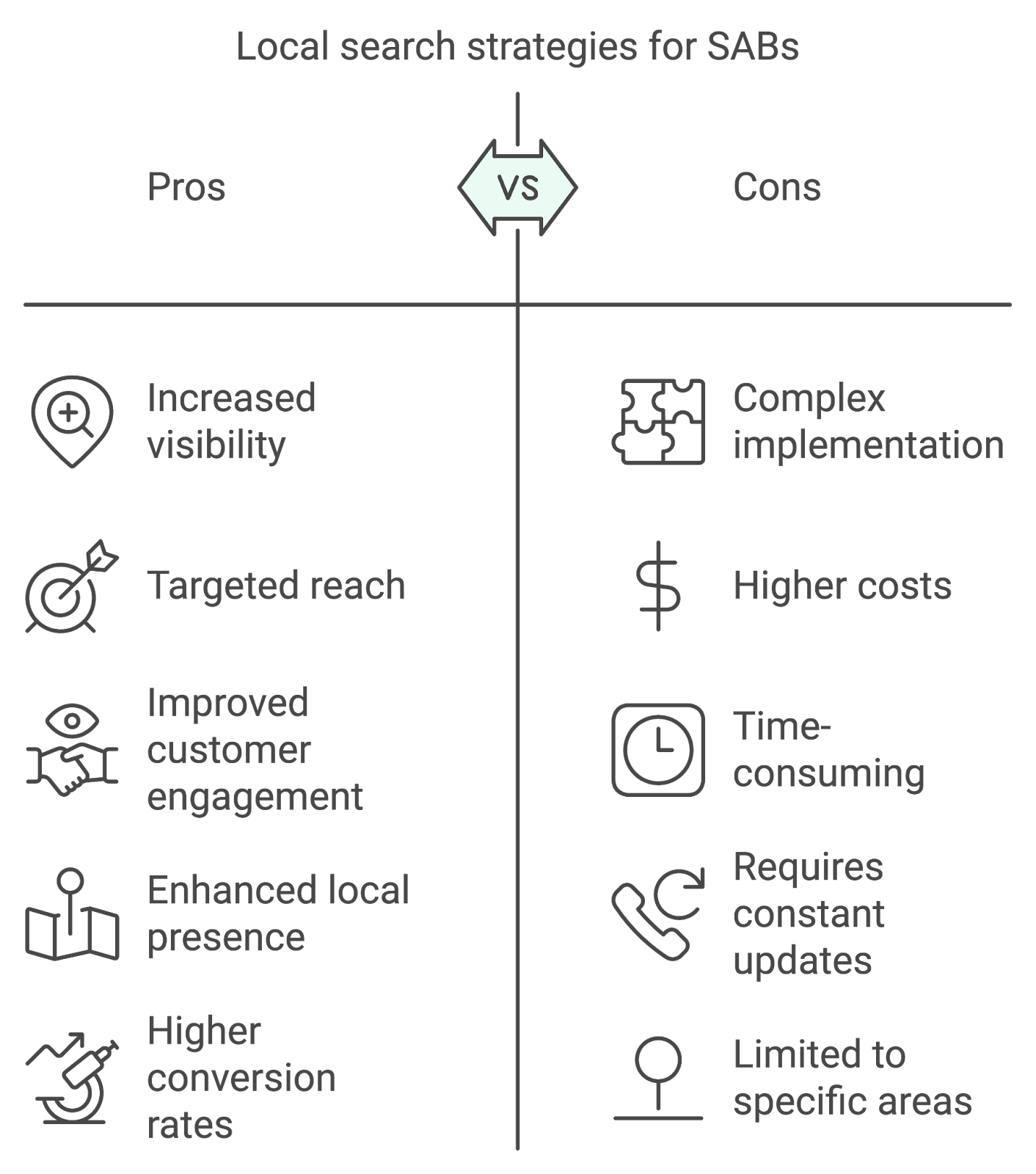
Tools und Strategien für die lokale Suche sind für Unternehmen, die Kunden an ihrem Standort betreuen, unterschiedlich zugeschnitten. Oft werden sie als Service Area Businesses (SABs) bezeichnet, da diese Unternehmen kein Ladengeschäft oder Büro haben, in dem Kunden sie besuchen können.
Stattdessen können SABs ihre Kunden erreichen, indem sie zu ihren Standorten reisen, was einen einzigartigen Ansatz erfordert, um in den lokalen Suchergebnissen angezeigt zu werden.
So unterscheidet sich die lokale Suche für SABs:
- Keine öffentliche Adresse in den Inseraten: Im Gegensatz zu Unternehmen mit einem physischen Standort zeigen SABs in ihren Online-Angeboten in der Regel keine bestimmte Adresse an. Stattdessen kennzeichnen sie einen Servicebereich, der alle Orte umfasst, an denen sie ihre Dienste anbieten möchten. Das hilft ihnen, bei Suchanfragen in mehreren Stadtteilen oder Städten zu erscheinen, sodass sie nicht nur auf einen Standort beschränkt sind.
- Erweiterter Servicebereich in der Suche: SABs profitieren von Suchstrategien, die sich auf mehrere lokale Gebiete konzentrieren und nicht auf ein einzelnes Viertel oder eine Stadt. Ihre Angebote müssen optimiert werden, um ein breiteres geografisches Spektrum abzudecken und Kunden in verschiedenen Städten oder Regionen anzusprechen.
- Lokales SEO ohne Fußgängerverkehr: Für SABs sind Schlüsselwörter und Inhalte, die bestimmte Dienste und Bereiche hervorheben, von entscheidender Bedeutung. Da sie keinen Besucherverkehr haben, verlassen sie sich stark darauf, bei lokalen Suchanfragen zu erscheinen, wenn potenzielle Kunden online suchen. SABs verwenden häufig Schlüsselwörter wie „in meiner Nähe“ oder die Namen der Städte und Stadtteile, in denen sie tätig sind, um mehr Menschen zu erreichen.
- Anpassung des Google-Unternehmensprofils: Google-Unternehmensprofile sind für SABs unverzichtbar, allerdings mit einigen einzigartigen Anpassungen. SABs können ihr Einzugsgebiet angeben, anstatt eine Straßenadresse anzugeben. So erscheinen sie bei Suchanfragen in ihrer gesamten Versorgungsregion, ohne dass ein physischer Standort auf der Karte angezeigt wird.
- Bewertungen und Reputation in mehreren Bereichen: Positive Bewertungen von Kunden aus verschiedenen Bereichen helfen SABs, sich bei lokalen Suchanfragen von der Masse abzuheben. Da sie mehrere Standorte anbieten, schaffen Bewertungen, in denen verschiedene Städte erwähnt werden, Vertrauen und verbessern die Sichtbarkeit.
Mithilfe dieser lokalen Suchstrategien können Unternehmen im Servicebereich Kunden in einem breiteren Umkreis erreichen, sodass Kunden sie auch ohne Ladenfront leicht finden und mit ihnen in Kontakt treten können.
Optimierung Ihres GBP-Profils als Unternehmen im Servicebereich
Jetzt, wo du alles eingerichtet hast, ist es an der Zeit, sicherzustellen, dass dein Profil für maximale Sichtbarkeit und Attraktivität optimiert ist. Hier sind einige Hinweise, die Sie beachten sollten, wenn Sie versuchen, Ihr GBP-Profil einzurichten.
- Ihre Unternehmensbeschreibung sollte präzise und klar sein und relevante Keywords wie Ihre Dienstleistungen und Ihren Standort enthalten. Vermeiden Sie Keyword-Stuffing, aber stellen Sie sicher, dass Sie hervorheben, was Ihr Unternehmen auszeichnet.
- Da lokales SEO für SABs von entscheidender Bedeutung ist, sollten Sie relevante lokale Keywords auf natürliche Weise in Ihr Profil einbeziehen. Dies könnte bedeuten, nahe gelegene Stadtteile oder Städte hinzuzufügen, in denen Sie tätig sind.
- Fotos sind eine große Sache für SABs. Fügen Sie Fotos hinzu, die Ihre Arbeit, Vorher-Nachher, Teamfotos oder Bilder Ihrer Servicefahrzeuge zeigen. Das schafft Vertrauen und zeigt potenziellen Kunden, was Sie tun können.
- Gute Bewertungen ziehen neue Kunden an und stärken Ihren Ruf. Bitten Sie zufriedene Kunden um Bewertungen, antworten Sie darauf (insbesondere auf negatives Feedback) und sorgen Sie dafür, dass es professionell bleibt.
- Attribute wie „im Besitz von Veteranen“ oder „umweltfreundlich“ verleihen Ihrem Profil mehr Persönlichkeit und helfen Kunden, Ihre Werte zu verstehen.
- Verwenden Sie den Abschnitt „Fragen und Antworten“, um häufig gestellte Kundenfragen zu beantworten. Auf diese Weise können Sie proaktiv auf Bedenken eingehen und Ihr Wissen unter Beweis stellen.
Aktualisierung Ihres GBP-Inhalts für Unternehmen im Servicebereich
Regelmäßige Inhaltsaktualisierungen
Es ist von entscheidender Bedeutung, Ihr GBP frisch und aktuell zu halten. Wenn Sie die Geschäftszeiten ändern, eine Dienstleistung hinzufügen oder etwas Neues anbieten, aktualisieren Sie Ihr Profil.
GBP-Posts verwenden
GBP-Beiträge sind wie Social-Media-Updates, erscheinen aber in Ihrem Profil. Verwende Beiträge, um saisonale Angebote, wichtige Updates oder bevorstehende Veranstaltungen zu teilen. Versuche, wöchentlich oder alle zwei Wochen zu posten, damit dein Profil aktiv bleibt.
Erstellung ansprechender Foto- und Videoinhalte
Fotos und Videos sollten Ihre Arbeit präsentieren. Zum Beispiel könnte ein Rasenpflegeunternehmen Fotos von einem frisch gemähten Garten hinzufügen, während ein Klempner ein Video von einer neuen Installation veröffentlicht. Dieser Inhalt hält die Leute bei der Stange und erhöht die Glaubwürdigkeit.
Nutzung von GBP Insights für die Inhaltsplanung
Die Statistiken von GBP zeigen dir, was funktioniert und was nicht. Wenn die Leute dich hauptsächlich über bestimmte Keywords finden, füge mehr davon zu deinem Profilinhalt hinzu. Oder, wenn deine Fotos viele Views bekommen, teile immer wieder neue.
Der Analysebereich von Google Business Profile, auch bekannt als Insights, liefert bekanntermaßen wichtige Daten darüber, wie Kunden Ihren Brancheneintrag finden und mit ihm interagieren. Diese Erkenntnisse belegen die Effektivität Ihres GBP-Profils, angefangen bei den Suchbegriffen, mit denen Kunden Sie erreichen, bis hin zu den spezifischen Maßnahmen, die sie ergreifen, sobald sie Ihr Profil gefunden haben.
Wenn Sie diese Daten untersuchen, können Sie fundierte Anpassungen vornehmen, die dazu beitragen, Ihre Sichtbarkeit zu erhöhen, Ihre Kundenbindung zu verbessern und Ihre Konversionsraten zu verbessern.
Lassen Sie uns etwas genauer darauf eingehen, diese Erkenntnisse besser zu verstehen.
GBP Insights verstehen

GBP Insights liefert Daten, die zwei Hauptfragen beantworten:
- Wie finden potenzielle Kunden Ihr Unternehmen?
- Was machen sie, wenn sie es gefunden haben?
Anhand dieser Daten können Sie feststellen, welche Aspekte Ihres Inserats Aufmerksamkeit erregen und welche möglicherweise verbessert werden müssen. Hier sind einige der wichtigsten Kennzahlen, die von GBP Insights bereitgestellt werden.
Suchanfragen, die verwendet wurden, um Ihr Unternehmen zu finden: Diese Keywords zeigen, was Kunden in Google eingeben, was sie zu Ihrem Profil führt. Sie können breit gefächert sein (z. B. „Landschaftsbauservice“) oder spezifisch (z. B. „24-Stunden-Klempner in Chicago“). Indem Sie diese Begriffe identifizieren, können Sie die Absicht Ihrer Kunden besser verstehen und Ihre Servicebeschreibungen an diese Anfragen anpassen. Wenn Sie beliebte Suchbegriffe direkt in Ihre Unternehmensbeschreibung oder in Ihre Servicelisten aufnehmen, erhöhen Sie Ihre Chancen, in Zukunft bei ähnlichen Suchanfragen zu erscheinen.
Aktionen des Kunden: Diese Metrik schlüsselt auf, was Kunden tun, nachdem sie Ihr Profil gefunden haben, insbesondere, ob sie Ihre Website besuchen, Ihr Unternehmen anrufen, nach einer Wegbeschreibung fragen oder Ihnen eine Nachricht senden (sofern Messaging aktiviert ist). Für SABs sind Aktionen wie Anrufe und Webseitenbesuche besonders wertvoll, da sie oft ein starkes Interesse an der Buchung einer Dienstleistung darstellen.
Wenn beispielsweise zu bestimmten Zeiten die Anzahl der Anrufe ansteigt, sollten Sie sicherstellen, dass die Mitarbeiter verfügbar sind, um Anfragen umgehend zu bearbeiten. Darüber hinaus könnte eine hohe Anzahl von „Website-Besuchen“ auf Interesse an detaillierteren Serviceinformationen hindeuten. Stellen Sie daher sicher, dass Ihre Website-Landingpages klare nächste Schritte und Kontaktmöglichkeiten enthalten.
Foto- und Videoansichten: GBP bietet auch Einblicke in die Häufigkeit, mit der Ihre Bilder und Videos angesehen werden. Ein hohes Engagement für visuelle Inhalte weist auf eine starke visuelle Anziehungskraft hin. Ihre Kunden suchen häufig nach Fotos, um die Qualität Ihrer Arbeit zu bestätigen. Wenn bestimmte Fotos durchweg häufiger angesehen werden, sollten Sie erwägen, ähnliche Bilder hinzuzufügen, um dieses Interesse zu nutzen. Wenn beispielsweise „Vorher-Nachher“ -Bilder viel Aufmerksamkeit auf sich ziehen, teilen Sie diese Art von Bildern weiterhin, um Ihre Ergebnisse zu präsentieren und Ihre Glaubwürdigkeit zu stärken.
Direktsuche im Vergleich zu Discovery-Suchen: Diese Aufschlüsselung zeigt, wie viele Kunden Ihr Unternehmen über „direkte“ Suchanfragen (wenn sie nach Ihrem Unternehmensnamen oder Ihrer Adresse suchen) im Vergleich zu „Discovery“ -Suchanfragen (wenn sie nach einer von Ihnen angebotenen Dienstleistung suchen) finden. Hohe Suchzahlen bedeuten, dass Kunden Sie finden, wenn sie nach Dienstleistungen suchen. Das ist ideal, um neue Kunden zu gewinnen. Wenn Ihre „direkten“ Suchanfragen hoch sind, deutet dies auf eine starke Markenbekanntheit hin. Stellen Sie sicher, dass Ihre Servicekategorien und Keywords die Vielfalt der von Ihnen angebotenen Dienstleistungen genau widerspiegeln, um die Suchanfragen zu erhöhen, die Sie „entdecken“.
Anrufe und Nachrichten nach Tag und Uhrzeit: GBP bietet auch eine Aufschlüsselung nach Tag und Uhrzeit für Kundenanrufe und Nachrichten. Diese Daten können Ihnen helfen, Ihre Verfügbarkeits- oder Reaktionsstrategien anzupassen. Wenn beispielsweise am Wochenende die meisten Anrufe anfallen, können Sie die Personalressourcen entsprechend zuweisen oder ein automatisiertes System verwenden, um eingehende Anfragen zu bearbeiten.
Einige prominente Nachteile eines SAB

Vermehrter Spam und unerwünschte Verkaufsgespräche
Um neue Kunden zu gewinnen, müssen SABs ihre Kontaktinformationen häufig in verschiedenen Online-Verzeichnissen, Kartendiensten und Bewertungsseiten auflisten. Dies trägt zwar zur Erhöhung ihrer Sichtbarkeit bei, öffnet aber auch die Tür für einen ständigen Strom von Spam-Anrufen und unaufgeforderten Verkaufsgesprächen von Unternehmen, die Werbung, Auflistungen von „Upgrades“ oder irrelevante Geschäftslösungen verkaufen möchten. Dies kann einen erheblichen Zeitaufwand bedeuten und von echten Kundenanrufen ablenken. SAB müssen daher in Tools zur Überprüfung von Anrufen oder separate Geschäftsbereiche investieren, um diese Unterbrechungen zu bewältigen.
Eingeschränktes Kundenvertrauen ohne physischen Standort
Viele Kunden fühlen sich wohler, wenn sie mit Unternehmen zusammenarbeiten, die über ein Ladengeschäft oder ein Büro verfügen. Bei einer SAB, die ohne öffentliche Adresse arbeitet, kann es zu einer Wahrnehmungslücke kommen. Manche Kunden machen sich Sorgen um die Rechenschaftspflicht oder die Legitimität des Unternehmens, wenn sie keinen konkreten Standort sehen können. Dies kann es für neue SABs schwierig machen, Vertrauen und Glaubwürdigkeit aufzubauen, insbesondere wenn sie mit etablierten, standortbezogenen Unternehmen konkurrieren.
Lokale SEO-Herausforderungen
Die lokale Suchmaschinenoptimierung spielt eine entscheidende Rolle dabei, SABs dabei zu helfen, ihre Zielgruppen zu erreichen, aber sie ist für sie komplexer als für traditionelle Unternehmen. Ohne eine physische Adresse zur Verankerung der Suchergebnisse sind SABs in ihren Online-Profilen stark auf klar definierte Servicebereiche, strategische Keywords und genaue geografische Tags angewiesen.
Im Gegensatz zu Ladengeschäften, die von Natur aus innerhalb ihrer spezifischen Stadt oder Nachbarschaft ranken, müssen SABs härter arbeiten, um in den Suchergebnissen einer breiteren Region zu erscheinen.
Kompliziertes Servicebereichsmanagement
SABs bedienen Kunden an verschiedenen Standorten, was die Planung, das Routing und die gesamte Logistik erschweren kann. Die Notwendigkeit, ein weites geografisches Gebiet abzudecken, führt häufig zu höheren Reisekosten und mehr Zeit auf der Straße, was wiederum die Kraftstoffkosten und den Verschleiß der Fahrzeuge erhöht. Daher wird die Verwaltung von Terminen, Routen und Reisezeiten von entscheidender Bedeutung, um Verzögerungen zu vermeiden und die Ausgaben unter Kontrolle zu halten. Diese zusätzliche Ebene des Logistikmanagements kann zu einer Belastung werden, insbesondere für kleinere SABs oder solche mit begrenztem Personal.
Starke Abhängigkeit von Telefon- und Online-Präsenz
SABs haben keinen physischen Standort, an dem Kunden vorbeikommen können, und verlassen sich fast ausschließlich auf ihre Telefon- und Online-Präsenz, um Kunden zu gewinnen und zu binden. Eine gut gepflegte Website, ein aktives Social-Media-Profil und ein reaktionsschneller Kundensupport sind unerlässlich, um einen guten ersten Eindruck zu hinterlassen. Alle Probleme mit der Online-Sichtbarkeit, wie ein schlechtes Website-Ranking oder negative Bewertungen, können sich direkt auf die Fähigkeit eines SAB auswirken, Geschäfte zu machen. Darüber hinaus können verpasste Anrufe oder langsame Reaktionszeiten potenzielle Kunden abschrecken, weshalb eine effektive Anrufbearbeitung von entscheidender Bedeutung ist.
Schwierigkeiten beim Aufbau eines lokalen Rufs
Für traditionelle Unternehmen trägt ein physischer Standort dazu bei, Vertrautheit und Anerkennung in der lokalen Gemeinschaft aufzubauen. SABs profitieren jedoch oft nicht von einer regelmäßigen, sichtbaren Interaktion mit der Gemeinschaft. Sie verlassen sich stark auf Kundenrezensionen, Mundpropaganda und digitales Marketing, um ihren Ruf aufzubauen. Dies kann Zeit in Anspruch nehmen und erfordert konsequente Anstrengungen. Ohne lokalen „Laufverkehr“ kann der Aufbau eines treuen Kundenstamms länger dauern, insbesondere wenn sie in Bereichen tätig sind, in denen der Wettbewerb stark ist oder die Kundenbindung bereits zu anderen lokalen Anbietern besteht.
Zusammenfassend lässt sich sagen, dass SABs zwar die Flexibilität genießen, mehrere Standorte zu bedienen und Kunden direkt zu erreichen, stehen jedoch vor einzigartigen Herausforderungen, die sich auf Glaubwürdigkeit, Sichtbarkeit, Logistik und Kundenbindung auswirken können.
Um diese Hürden zu überwinden, benötigen SABs häufig eine starke Online-Präsenz, ein proaktives Reputationsmanagement und eine effiziente Servicebereichslogistik, um Vertrauen aufzubauen, die Kosten zu kontrollieren und sich auf einem wettbewerbsintensiven Markt abzuheben.
Zusammenfassend...
Service Area-Unternehmen haben zwar einige deutliche Nachteile, sind aber dennoch sehr vielseitig und helfen bei der Erbringung von Dienstleistungen an verschiedenen Standorten. Die Einrichtung und der Einstieg sollten also nicht kompliziert sein.
Sobald alles richtig gemacht ist, schneiden Unternehmen im Servicebereich genauso gut ab wie alle anderen lokalen Unternehmen. Worauf Sie bei der Einrichtung eines Unternehmens achten sollten, sind tolle Bewertungen und Fotos, die Ihnen helfen können, Vertrauen aufzubauen und die Leute dazu zu bringen, Sie anderen Fachleuten vorzuziehen.
Es kann einige Zeit dauern, bis Sie dort ankommen, aber sobald Sie dort sind, wird Ihr Unternehmen genauso florieren wie jedes andere Unternehmen!
Häufig gestellte Fragen
1. Was bedeutet Servicebereich im Google-Unternehmensprofil?
Mit dem Servicebereich im Google-Unternehmensprofil können Unternehmen angeben, welche Regionen oder Standorte sie beliefern, insbesondere wenn sie kein Ladengeschäft haben. Es hilft Kunden zu verstehen, wo Ihre Dienste verfügbar sind, sodass es einfacher ist, mit lokalen Leads in diesen Regionen in Kontakt zu treten
2. Kann ich meinem Google-Unternehmensprofil Dienste hinzufügen?
Ja, Sie können bestimmte Dienste in Ihrem Google-Unternehmensprofil auflisten. Durch das Hinzufügen von Diensten erhalten Kunden eine schnelle Vorstellung davon, was Sie anbieten. Dies kann die Sichtbarkeit bei relevanten Suchanfragen verbessern und Nutzern helfen, genau das zu finden, was sie benötigen.
3. Ist Google Business Profile nur für lokale Unternehmen bestimmt?
Google Business Profile wurde in erster Linie für Unternehmen mit lokaler Präsenz entwickelt, ist aber auch für dienstleistungsorientierte Unternehmen nützlich, die in bestimmten Bereichen ohne Ladengeschäft tätig sind. Es hilft jedem Unternehmen, mit Kunden in der Nähe in Kontakt zu treten und bei relevanten lokalen Suchanfragen zu erscheinen.
4. Wie funktionieren Google-Unternehmensprofile?
Ein Google-Unternehmensprofil zeigt Ihre Unternehmensinformationen wie Öffnungszeiten, Standort, Kontaktdaten und Bewertungen in der Google-Suche und auf Google Maps an. Es ist eine einfache Möglichkeit für potenzielle Kunden, Ihr Unternehmen online zu finden und sich darüber zu informieren, und es erhöht Ihre Chancen, in den lokalen Suchergebnissen zu erscheinen.




